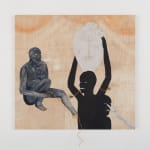Kelton Campos Fausto
ìdódó, 2024
pigmentos naturais e acrílica sobre tela
[natural pigments and acrylic on canvas]
[natural pigments and acrylic on canvas]
140 x 147 x 3.5 cm
[55 1/8 x 57 7/8 x 1 3/8 in]
[55 1/8 x 57 7/8 x 1 3/8 in]
Copyright O Artista
Mais imagens
-
(View a larger image of thumbnail 1
)

-
(View a larger image of thumbnail 2
)

-
(View a larger image of thumbnail 3
)

-
(View a larger image of thumbnail 4
)

-
(View a larger image of thumbnail 5
)

-
(View a larger image of thumbnail 6
)

-
(View a larger image of thumbnail 7
)

-
(View a larger image of thumbnail 8
)

-
(View a larger image of thumbnail 9
)

-
(View a larger image of thumbnail 10
)

'ìdódó' (umbigo) explora a criação de um amuleto de proteção feito com palha, elemento que simboliza a eternidade e transcendência. Três figuras habitam a cena: uma pessoa mais velha, símbolo...
"ìdódó" (umbigo) explora a criação de um amuleto de proteção feito com palha, elemento que simboliza a eternidade e transcendência. Três figuras habitam a cena: uma pessoa mais velha, símbolo de sabedoria, que confecciona o objeto de proteção. A segunda, com os braços envolvidos por esse poder ancestral, carrega um grande vaso que representa equilíbrio. A terceira figura, mais jovem, tem os olhos vendados, refletindo a necessidade de ver para crer, mesmo estando cercada por sua ancestralidade. A obra evoca a relação entre o tangível e o espiritual.
[“ìdódó” (navel) explores the creation of a protective amulet made from straw, an element that symbolizes eternity and transcendence. Three figures inhabit the scene: an older person, a symbol of wisdom, who makes the protective object. The second, with arms wrapped around this ancestral power, carries a large vase that represents balance. The third figure, younger, is blindfolded, reflecting the need to see in order to believe, even though she is surrounded by her ancestry. The work evokes the relationship between the tangible and the spiritual.]
[“ìdódó” (navel) explores the creation of a protective amulet made from straw, an element that symbolizes eternity and transcendence. Three figures inhabit the scene: an older person, a symbol of wisdom, who makes the protective object. The second, with arms wrapped around this ancestral power, carries a large vase that represents balance. The third figure, younger, is blindfolded, reflecting the need to see in order to believe, even though she is surrounded by her ancestry. The work evokes the relationship between the tangible and the spiritual.]









